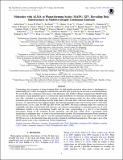Files in this item
Molecules with ALMA at Planet-forming Scales (MAPS). XIV. Revealing disk substructures in multiwavelength continuum emission
Item metadata
| dc.contributor.author | Sierra, Anibal | |
| dc.contributor.author | Pérez, Laura M. | |
| dc.contributor.author | Zhang, Ke | |
| dc.contributor.author | Law, Charles J. | |
| dc.contributor.author | Guzmán, Viviana V. | |
| dc.contributor.author | Qi, Chunhua | |
| dc.contributor.author | Bosman, Arthur D. | |
| dc.contributor.author | Öberg, Karin I. | |
| dc.contributor.author | Andrews, Sean M. | |
| dc.contributor.author | Long, Feng | |
| dc.contributor.author | Teague, Richard | |
| dc.contributor.author | Booth, Alice S. | |
| dc.contributor.author | Walsh, Catherine | |
| dc.contributor.author | Wilner, David J. | |
| dc.contributor.author | Ménard, François | |
| dc.contributor.author | Cataldi, Gianni | |
| dc.contributor.author | Czekala, Ian | |
| dc.contributor.author | Bae, Jaehan | |
| dc.contributor.author | Huang, Jane | |
| dc.contributor.author | Bergner, Jennifer B. | |
| dc.contributor.author | Ilee, John D. | |
| dc.contributor.author | Benisty, Myriam | |
| dc.contributor.author | Le Gal, Romane | |
| dc.contributor.author | Loomis, Ryan A. | |
| dc.contributor.author | Tsukagoshi, Takashi | |
| dc.contributor.author | Liu, Yao | |
| dc.contributor.author | Yamato, Yoshihide | |
| dc.contributor.author | Aikawa, Yuri | |
| dc.date.accessioned | 2023-11-21T17:30:01Z | |
| dc.date.available | 2023-11-21T17:30:01Z | |
| dc.date.issued | 2021-11 | |
| dc.identifier | 295922456 | |
| dc.identifier | 3746424c-6c5f-40dc-afb7-206a009fbbe8 | |
| dc.identifier | 85119981277 | |
| dc.identifier.citation | Sierra , A , Pérez , L M , Zhang , K , Law , C J , Guzmán , V V , Qi , C , Bosman , A D , Öberg , K I , Andrews , S M , Long , F , Teague , R , Booth , A S , Walsh , C , Wilner , D J , Ménard , F , Cataldi , G , Czekala , I , Bae , J , Huang , J , Bergner , J B , Ilee , J D , Benisty , M , Le Gal , R , Loomis , R A , Tsukagoshi , T , Liu , Y , Yamato , Y & Aikawa , Y 2021 , ' Molecules with ALMA at Planet-forming Scales (MAPS). XIV. Revealing disk substructures in multiwavelength continuum emission ' , Astrophysical Journal Supplement Series , vol. 257 , no. 1 , 14 . https://doi.org/10.3847/1538-4365/ac1431 | en |
| dc.identifier.issn | 0067-0049 | |
| dc.identifier.other | BibCode: 2021ApJS..257...14S | |
| dc.identifier.other | ORCID: /0000-0002-1483-8811/work/146464242 | |
| dc.identifier.uri | https://hdl.handle.net/10023/28742 | |
| dc.description | Funding: I.C. was supported by NASA through the NASA Hubble Fellowship grant HST-HF2-51405.001-A awarded by the Space Telescope Science Institute, which is operated by the Association of Universities for Research in Astronomy, Inc., for NASA, under contract NAS5-26555. A.S.B acknowledges the studentship funded by the Science and Technology Facilities Council of the United Kingdom (STFC). C.W. acknowledges financial support from the University of Leeds, STFC and UKRI (grant Nos. ST/R000549/1, ST/T000287/1, MR/T040726/1). | en |
| dc.description.abstract | Constraining dust properties of planet-forming disks via high-angular-resolution observations is fundamental to understanding how solids are trapped in substructures and how dust growth may be favored or accelerated therein. We use ALMA dust continuum observations of the Molecules with ALMA at Planet-forming Scales (MAPS) disks and explore a large parameter space to constrain the radial distribution of solid mass and maximum grain size in each disk, including or excluding dust scattering. In the nonscattering model, the dust surface density and maximum grain size profiles decrease from the inner disks to the outer disks, with local maxima at the bright ring locations, as expected from dust trapping models. The inferred maximum grain sizes from the inner to outer disks decrease from 1 cm to 1 mm. For IM Lup, HD 163296, and MWC 480 in the scattering model, two solutions are compatible with their observed inner disk emission: one solution corresponding to a maximum grain size of a few millimeters (similar to the nonscattering model), and the other corresponding to a size of a few hundred micrometers. Based on the estimated Toomre parameter, only IM Lup-which shows a prominent spiral morphology in millimeter dust-is found to be gravitationally unstable. The estimated maximum Stokes number in all the disks lies between 0.01 and 0.3, and the estimated turbulence parameters in the rings of AS 209 and HD 163296 are close to the threshold where dust growth is limited by turbulent fragmentation. This paper is part of the MAPS special issue of the Astrophysical Journal Supplement. | |
| dc.format.extent | 6147744 | |
| dc.language.iso | eng | |
| dc.relation.ispartof | Astrophysical Journal Supplement Series | en |
| dc.subject | Circumstellar dust | en |
| dc.subject | Interstellar scattering | en |
| dc.subject | Radiative transfer | en |
| dc.subject | Radio continuum emission | en |
| dc.subject | Protoplanetary disks | en |
| dc.subject | QB Astronomy | en |
| dc.subject | QC Physics | en |
| dc.subject | 3rd-DAS | en |
| dc.subject.lcc | QB | en |
| dc.subject.lcc | QC | en |
| dc.title | Molecules with ALMA at Planet-forming Scales (MAPS). XIV. Revealing disk substructures in multiwavelength continuum emission | en |
| dc.type | Journal article | en |
| dc.contributor.institution | University of St Andrews. School of Physics and Astronomy | en |
| dc.identifier.doi | https://doi.org/10.3847/1538-4365/ac1431 | |
| dc.description.status | Peer reviewed | en |
| dc.identifier.url | https://arxiv.org/abs/2109.06433 | en |
| dc.identifier.url | http://adsabs.harvard.edu/abs/2021ApJS..257...14S | en |
This item appears in the following Collection(s)
Items in the St Andrews Research Repository are protected by copyright, with all rights reserved, unless otherwise indicated.

